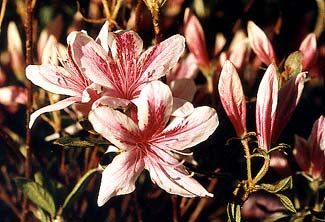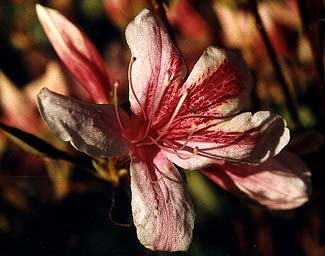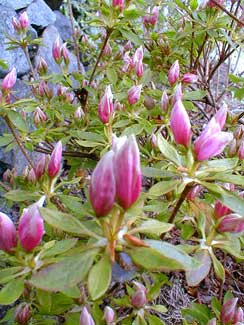 Azalea 'Pixi'
Azalea 'Pixi'
The Mysterious Hybrid
"Art is the unceasing effort to compete with the beauty of flowers -- & never succeeding."
-Marc Chagall
(1887-1985)
(1887-1985)
I had no idea what species affiliation this cultivar may have had when I planted it. It was labeled very simply as Azalea 'Pixi' in a local nursery, with the "common" name merely restated on the same label as "Pixi Evergreen Azalea." And while it does have a pixie-like quality to it, the name likely alludes to its somewhat carnation picotee coloration, a white bloom streaked & edged in deep blood-purple.
 It was the only one the nursery had, though everything else they stocked was carried in-depth. Whether the seller had a run on them & only one was left, or it was something offbeat of which a wholesaler had few, I'll never know for certain, but its evident rarity suggests the latter.
It was the only one the nursery had, though everything else they stocked was carried in-depth. Whether the seller had a run on them & only one was left, or it was something offbeat of which a wholesaler had few, I'll never know for certain, but its evident rarity suggests the latter.The seller put it among numerous Kurume hybrids under a big sign about how excellent Kurume highbrids are (& they certainly are that, including as Kurumes do the ultra-popular Hino Crimson). Most of their Kurumes except the three most common ones were pricy, but this lone 'Pixi' was very cheap, for no reason I could discern unless due to its nearly deciduous appearance compared to leafier evergreens.
Granny Artemis picked it out of the lot as being strikingly different from any azalea in our gardens. We'd just that day been saying we should not add any others unless they resembled nothing we already have.
Not knowing any special needs it might have, & finding nothing about it in my handful of books or from on-line resources, I gave it a "best guess" from appearances & provided it with a bright morning-sunny & subdued afternoon-shady location.
 But nearby shrubs were fast-growing & soon overwhelmed & hid the small 'Pixi,' & it ended up so overshadowed & unable to fend for itself for water resources that it did not set buds for its second year. So I was forced to transplant it in better morning-sun conditions with a row of shrubs not so apt to overwhelm it.
But nearby shrubs were fast-growing & soon overwhelmed & hid the small 'Pixi,' & it ended up so overshadowed & unable to fend for itself for water resources that it did not set buds for its second year. So I was forced to transplant it in better morning-sun conditions with a row of shrubs not so apt to overwhelm it.The first two photos are form its first year in the original location, where it bloomed in April. The third photo is of the buds two years later in the new location, during the last week of March; it was ready to burst into flower a full month earlier than it had previously done.
Since I had no information to hand about this variety, I asked Steve Henning if he knew anything about 'Pixi.' He has many wonderful rhododendron articles & links at Stephen M. Henning's Rhododendron Pages, & he has the best rhododendron library. From his resources he was able to tell me, "The Belgian Indian or Indica evergreen azalea 'Pixi' is a Greentree introduction from 1973. It is described as white with purple stripes." Stephen noted he'd never seen a specimen, but from my pictures of it he thought it resembled the Glenn Dale evergreen azalea 'Pixie' (but that one has a red blotch as well as the red-purple rays, so Pixi was not a typo for Pixie) or the Glenn Dale 'Benn Morrison.'
The Belgian Indian hybrids are frequently compared to & even crossed with Japanese Kurumes so it was totally reasonable that the nursery had tossed the lone Pixi in with the Kurumes. Indica hybrids were developed inside greenhouses in Belgium in the mid-1800s, thus are tender to the cold & sometimes known as "Pot Azaleas" since they may need to be grown in containers that can be brought in from the winter. Our mild winters aren't generally harmful to pot azaleas if they can be provided a location protected from winter winds. As a later hybrid of Greentree (in Maryland) I assume they did further develop their Indica to be less tender than the original "pot azaleas."
The primary parentage of Belgian Indica has in the past been assumed to be R. indicum but is now known to have been R. simsii. Though the ten year height of the parent shrub is only three or four feet, most Indica hybrids grow four to six feet in ten years.
For more photos, go to the
'Pixi' page of the Azalea & Rhododendron Blossoms Gallery
'Pixi' page of the Azalea & Rhododendron Blossoms Gallery